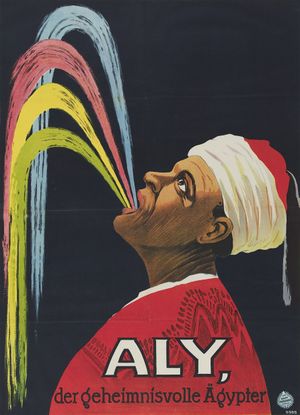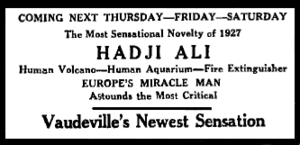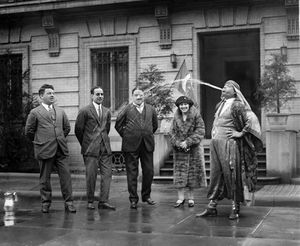حاجي علي
حاجي علي | |
|---|---|
 ملصق دعائية لشركة أدولف فرايدلاندر 1913؛ "ترجمة التعليق بالألمانية "علي، المصري الغامض". | |
| وُلِدَ | حاجي علي ح. 1888–92 |
| توفي | 5 نوفمبر 1937 |
| أسماء أخرى | الرجل المصري المعجزة العظيم؛ المتقيئ المثير؛ اللغز المصري؛ البركان البشري؛ الحياة المائية البشرية؛ المعجزة التاسعة في دنيا العلوم |
| المهنة | فنان مسرحيات هزلية |
حاجي علي (ح. 1888–92 – 5 نوفمبر 1937)، هو فنان مسرحي هزلي، يُعتقد أنه من أصل مصري، واشتهر بأداؤه شخصية القلس. اشتهر حاج علي بارتجاع المياه، الدخان، الجوز والمناديل حسب اختيار الجماهير. كانت أشهر حيله شرب كميات من المياه يعقها الكيروسين، ثم قذف اللهب من فمه ثم اطفاء الحريق بنفثه للمياه على ديكورات المسرح. كان أثناء العرض يدعو المشاهدين لرؤية الأداء عن قرب للتأكد من عدم وجود أي حيلة.
بالرغم من عدم تحقيقه شهرة واسعة، فقد كان له حضور قوي في دائرة المسرح الهزلي بالولايات المتحدة. قام حاجي علي بأداء عروضه أمام رؤساء الدول منهم القيصر نيقولاي الثاني من روسيا. وكان أفضل المسرحيين الهزليين جودي گارلاند وكان الساحر المفضل لديڤد بلين. ظهرت أجزاء من عروضه في الفيلم القصير غريب كما يبدو (1930) وفي پوليتيكيرياس (1931)، الإصدار الإسپاني من الدجاج في المنزل للورل وهاردي. واحتوى فيلمان وثائقيان على لقطات لحاجي علي أخذت من پوليتيكيرياس: گيمزو! 1977، والمسرح الهزلي 1999. يمتلك حاجي علي قدرات معوية غير عادية أدت إلى رواج شائعات حول أن معهد روكفلر عرض مكافأة مالية ضخمة للحصول على معدته بعد وفاته. بعد وفاته في إنگلترة، عُرض جثمانه على جامعة جونز هوپكينز لدراسته، لكن العرض رفض.
خلفية
العروض
—كولونل جوليان، مدير أعمال علي[1]
ظهوره في الأفلام
—The Speed of Sound: Hollywood and the Talkie Revolution (1997)[2]
وفاته
انظر أيضاً
الهوامش
- ^ A number of online and book sources give Ali's year of birth as 1892 or approximately 1892. However, Ali's daughter stated to reporters after her father's death in 1937 that "he was only forty-nine."[3][1] If Ali's daughter was accurate about her father's age at the time of his death, he was born in 1887 or '88.
- ^ Ali's entry in Vaudeville, Old & New: An Encyclopedia of Variety Performers in America speculates that "Hadji Ali" may have been an alias or a simplification of an unknown birth name, and that there was little proof he was actually from Egypt.[4]
- ^ The ten years of age figure is attributed to an interview Ali gave to a correspondent for The Morning Bulletin while performing in Australia.[5] By contrast, after her father died, Almina Ali was quoted in The Gleaner as stating he had first learned of his abilities at seven years of age.[1]
- ^ According to the United States Consumer Price Index, a $1,000 per week salary in 1937 translates to approximately $16٬200 per week as of 2026.[6]
- ^ "Human Ostrich" in this passage refers to the conventional wisdom that ostriches will "eat anything".[7] While ostriches may be more selective than the adage provides, they are known to indiscriminately swallow shiny objects[8] and to eat small rocks naturally as an aid in their digestive process.[9] When one Australian newspaper described Ali and other regurgitators in like fashion, the expression became "Human Emus".[10]
المصادر
- ^ أ ب ت خطأ استشهاد: وسم
<ref>غير صحيح؛ لا نص تم توفيره للمراجع المسماةGleaner - ^ خطأ استشهاد: وسم
<ref>غير صحيح؛ لا نص تم توفيره للمراجع المسماةEyman - ^ خطأ استشهاد: وسم
<ref>غير صحيح؛ لا نص تم توفيره للمراجع المسماةDaily Express - ^ خطأ استشهاد: وسم
<ref>غير صحيح؛ لا نص تم توفيره للمراجع المسماةVaudeville - ^ خطأ استشهاد: وسم
<ref>غير صحيح؛ لا نص تم توفيره للمراجع المسماةBulletin - ^ Consumer Price Index (estimate) 1800–2008. Federal Reserve Bank of Minneapolis. Retrieved December 7, 2010.
- ^ Cornell University Laboratory of Ornithology (1994). Living Bird. Ithaca, NY: Cornell Laboratory of Ornithology. 13–14. OCLC 24618159.
{{cite journal}}: Missing or empty|title=(help) - ^ "Root of Evil" (fee required). Kokomo Tribune. Kokomo, IN. Associated Press. September 1, 1969.
- ^ Caroline Arnold (January 1990). Ostriches and Other Flightless Birds. Minneapolis, MN: Lerner Publications. p. 21. ISBN 978-0-87614-377-3.
- ^ "'Human Emus': Cases Described". The Cairns Post. Cairns, Qld. November 9, 1937.
وصلات خارجية
 Media related to Hadji Ali at Wikimedia Commons
Media related to Hadji Ali at Wikimedia Commons- 1934 Hadji Ali postcard from Ripley's Believe it or Not's "Odditorium" exhibit

